LEADERSHIP 3: Transformational Leadership in Contemporary Challenges
VerifiedAdded on 2020/05/16
|10
|2412
|65
Essay
AI Summary
This essay delves into the realm of transformational leadership, examining its pivotal role in addressing contemporary organizational challenges. The study highlights the importance of effective leadership in achieving success and competitive advantages in the global market. It focuses on the charismatic aspect of transformational leadership, emphasizing its ability to enhance employee motivation, foster innovation, and facilitate organizational change. The essay discusses various leadership challenges, including motivating team members, employee development, and adapting to changing organizational structures. It uses the Asda case study as an example, illustrating how transformational leadership can be applied to overcome financial difficulties and improve employee satisfaction. The study also explores the key components of transformational leadership, such as inspirational motivation, intellectual stimulation, and individual consideration, and how these elements contribute to organizational success. The essay concludes by emphasizing the effectiveness of transformational leadership compared to other leadership theories, and its potential for long-term organizational sustainability.
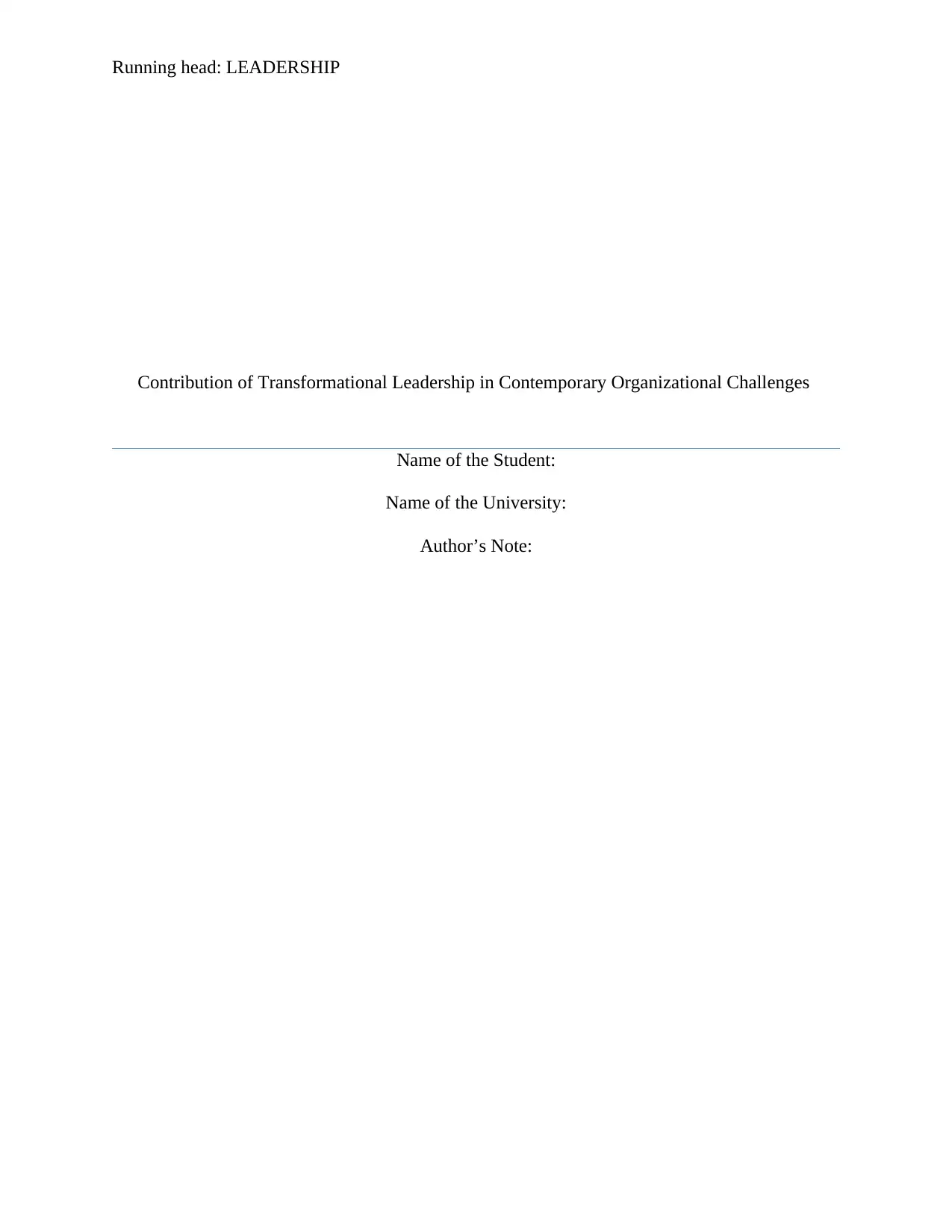
Running head: LEADERSHIP
Contribution of Transformational Leadership in Contemporary Organizational Challenges
Name of the Student:
Name of the University:
Author’s Note:
Contribution of Transformational Leadership in Contemporary Organizational Challenges
Name of the Student:
Name of the University:
Author’s Note:
Paraphrase This Document
Need a fresh take? Get an instant paraphrase of this document with our AI Paraphraser
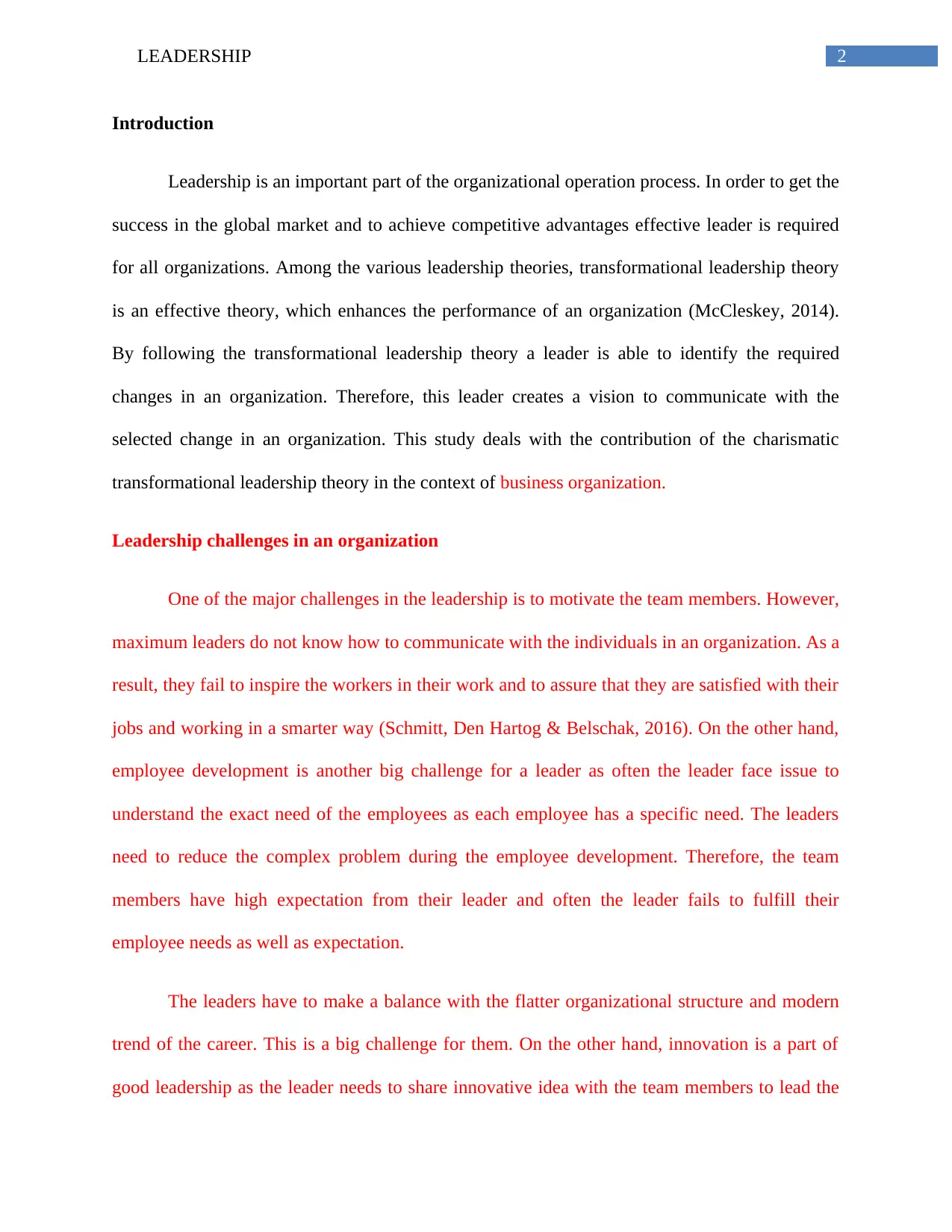
2LEADERSHIP
Introduction
Leadership is an important part of the organizational operation process. In order to get the
success in the global market and to achieve competitive advantages effective leader is required
for all organizations. Among the various leadership theories, transformational leadership theory
is an effective theory, which enhances the performance of an organization (McCleskey, 2014).
By following the transformational leadership theory a leader is able to identify the required
changes in an organization. Therefore, this leader creates a vision to communicate with the
selected change in an organization. This study deals with the contribution of the charismatic
transformational leadership theory in the context of business organization.
Leadership challenges in an organization
One of the major challenges in the leadership is to motivate the team members. However,
maximum leaders do not know how to communicate with the individuals in an organization. As a
result, they fail to inspire the workers in their work and to assure that they are satisfied with their
jobs and working in a smarter way (Schmitt, Den Hartog & Belschak, 2016). On the other hand,
employee development is another big challenge for a leader as often the leader face issue to
understand the exact need of the employees as each employee has a specific need. The leaders
need to reduce the complex problem during the employee development. Therefore, the team
members have high expectation from their leader and often the leader fails to fulfill their
employee needs as well as expectation.
The leaders have to make a balance with the flatter organizational structure and modern
trend of the career. This is a big challenge for them. On the other hand, innovation is a part of
good leadership as the leader needs to share innovative idea with the team members to lead the
Introduction
Leadership is an important part of the organizational operation process. In order to get the
success in the global market and to achieve competitive advantages effective leader is required
for all organizations. Among the various leadership theories, transformational leadership theory
is an effective theory, which enhances the performance of an organization (McCleskey, 2014).
By following the transformational leadership theory a leader is able to identify the required
changes in an organization. Therefore, this leader creates a vision to communicate with the
selected change in an organization. This study deals with the contribution of the charismatic
transformational leadership theory in the context of business organization.
Leadership challenges in an organization
One of the major challenges in the leadership is to motivate the team members. However,
maximum leaders do not know how to communicate with the individuals in an organization. As a
result, they fail to inspire the workers in their work and to assure that they are satisfied with their
jobs and working in a smarter way (Schmitt, Den Hartog & Belschak, 2016). On the other hand,
employee development is another big challenge for a leader as often the leader face issue to
understand the exact need of the employees as each employee has a specific need. The leaders
need to reduce the complex problem during the employee development. Therefore, the team
members have high expectation from their leader and often the leader fails to fulfill their
employee needs as well as expectation.
The leaders have to make a balance with the flatter organizational structure and modern
trend of the career. This is a big challenge for them. On the other hand, innovation is a part of
good leadership as the leader needs to share innovative idea with the team members to lead the
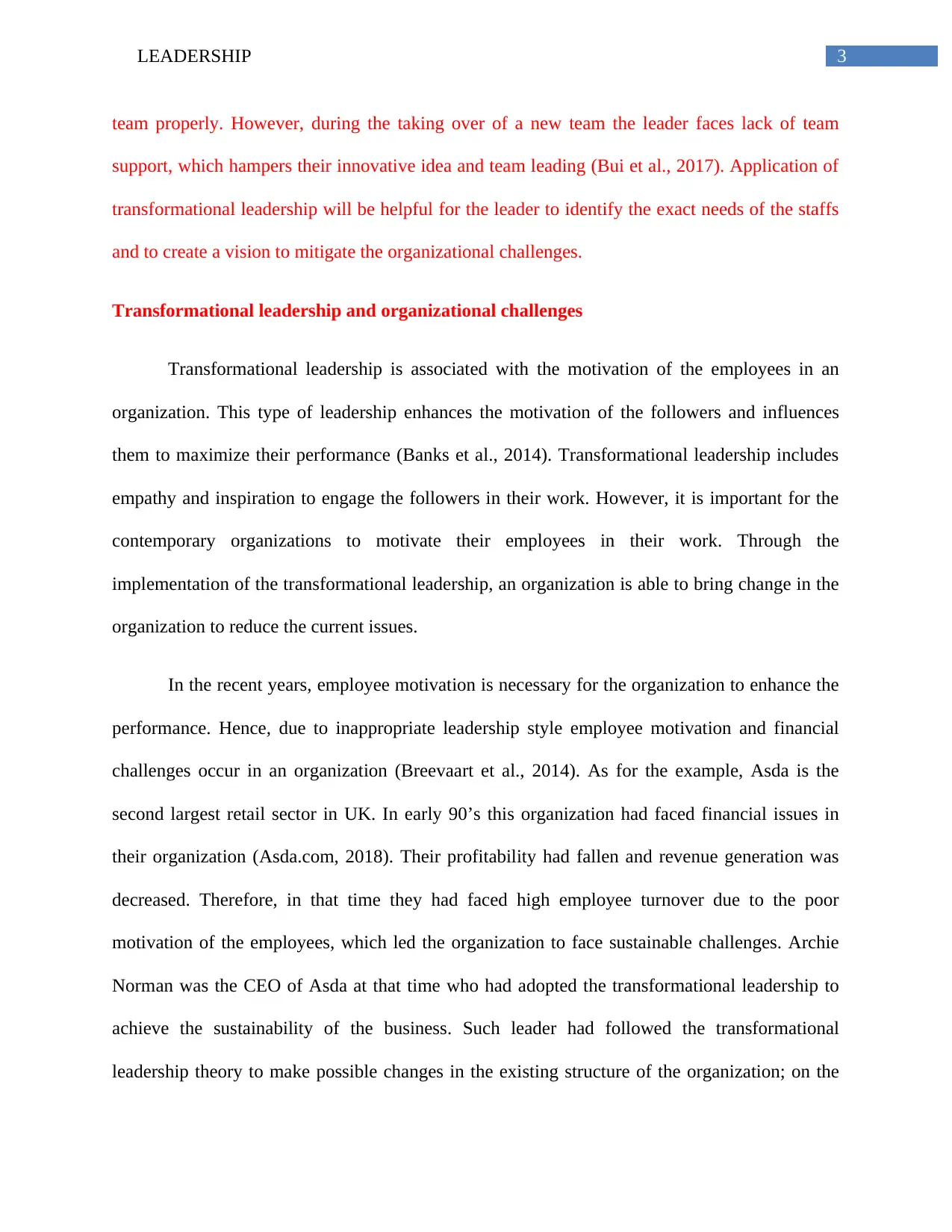
3LEADERSHIP
team properly. However, during the taking over of a new team the leader faces lack of team
support, which hampers their innovative idea and team leading (Bui et al., 2017). Application of
transformational leadership will be helpful for the leader to identify the exact needs of the staffs
and to create a vision to mitigate the organizational challenges.
Transformational leadership and organizational challenges
Transformational leadership is associated with the motivation of the employees in an
organization. This type of leadership enhances the motivation of the followers and influences
them to maximize their performance (Banks et al., 2014). Transformational leadership includes
empathy and inspiration to engage the followers in their work. However, it is important for the
contemporary organizations to motivate their employees in their work. Through the
implementation of the transformational leadership, an organization is able to bring change in the
organization to reduce the current issues.
In the recent years, employee motivation is necessary for the organization to enhance the
performance. Hence, due to inappropriate leadership style employee motivation and financial
challenges occur in an organization (Breevaart et al., 2014). As for the example, Asda is the
second largest retail sector in UK. In early 90’s this organization had faced financial issues in
their organization (Asda.com, 2018). Their profitability had fallen and revenue generation was
decreased. Therefore, in that time they had faced high employee turnover due to the poor
motivation of the employees, which led the organization to face sustainable challenges. Archie
Norman was the CEO of Asda at that time who had adopted the transformational leadership to
achieve the sustainability of the business. Such leader had followed the transformational
leadership theory to make possible changes in the existing structure of the organization; on the
team properly. However, during the taking over of a new team the leader faces lack of team
support, which hampers their innovative idea and team leading (Bui et al., 2017). Application of
transformational leadership will be helpful for the leader to identify the exact needs of the staffs
and to create a vision to mitigate the organizational challenges.
Transformational leadership and organizational challenges
Transformational leadership is associated with the motivation of the employees in an
organization. This type of leadership enhances the motivation of the followers and influences
them to maximize their performance (Banks et al., 2014). Transformational leadership includes
empathy and inspiration to engage the followers in their work. However, it is important for the
contemporary organizations to motivate their employees in their work. Through the
implementation of the transformational leadership, an organization is able to bring change in the
organization to reduce the current issues.
In the recent years, employee motivation is necessary for the organization to enhance the
performance. Hence, due to inappropriate leadership style employee motivation and financial
challenges occur in an organization (Breevaart et al., 2014). As for the example, Asda is the
second largest retail sector in UK. In early 90’s this organization had faced financial issues in
their organization (Asda.com, 2018). Their profitability had fallen and revenue generation was
decreased. Therefore, in that time they had faced high employee turnover due to the poor
motivation of the employees, which led the organization to face sustainable challenges. Archie
Norman was the CEO of Asda at that time who had adopted the transformational leadership to
achieve the sustainability of the business. Such leader had followed the transformational
leadership theory to make possible changes in the existing structure of the organization; on the
⊘ This is a preview!⊘
Do you want full access?
Subscribe today to unlock all pages.

Trusted by 1+ million students worldwide
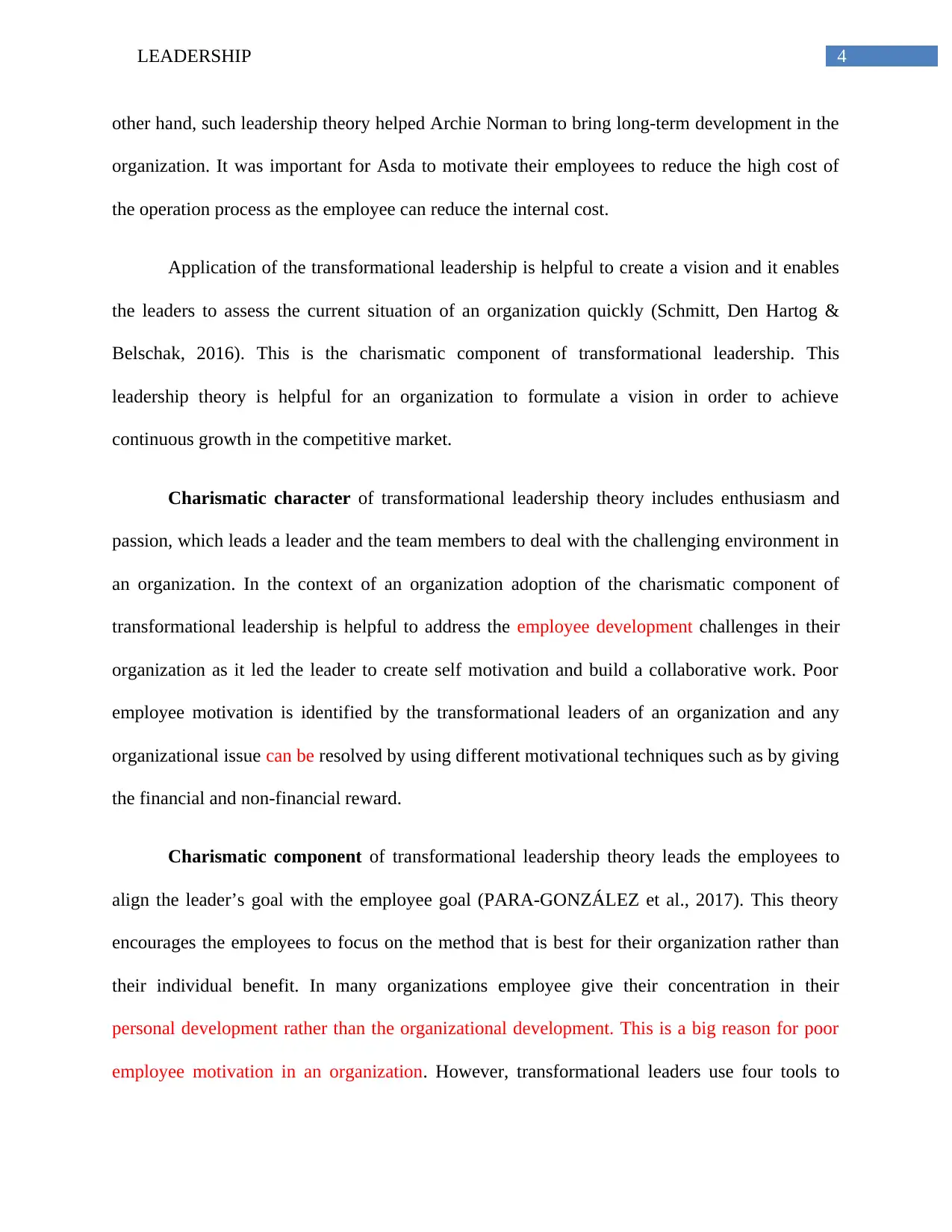
4LEADERSHIP
other hand, such leadership theory helped Archie Norman to bring long-term development in the
organization. It was important for Asda to motivate their employees to reduce the high cost of
the operation process as the employee can reduce the internal cost.
Application of the transformational leadership is helpful to create a vision and it enables
the leaders to assess the current situation of an organization quickly (Schmitt, Den Hartog &
Belschak, 2016). This is the charismatic component of transformational leadership. This
leadership theory is helpful for an organization to formulate a vision in order to achieve
continuous growth in the competitive market.
Charismatic character of transformational leadership theory includes enthusiasm and
passion, which leads a leader and the team members to deal with the challenging environment in
an organization. In the context of an organization adoption of the charismatic component of
transformational leadership is helpful to address the employee development challenges in their
organization as it led the leader to create self motivation and build a collaborative work. Poor
employee motivation is identified by the transformational leaders of an organization and any
organizational issue can be resolved by using different motivational techniques such as by giving
the financial and non-financial reward.
Charismatic component of transformational leadership theory leads the employees to
align the leader’s goal with the employee goal (PARA-GONZÁLEZ et al., 2017). This theory
encourages the employees to focus on the method that is best for their organization rather than
their individual benefit. In many organizations employee give their concentration in their
personal development rather than the organizational development. This is a big reason for poor
employee motivation in an organization. However, transformational leaders use four tools to
other hand, such leadership theory helped Archie Norman to bring long-term development in the
organization. It was important for Asda to motivate their employees to reduce the high cost of
the operation process as the employee can reduce the internal cost.
Application of the transformational leadership is helpful to create a vision and it enables
the leaders to assess the current situation of an organization quickly (Schmitt, Den Hartog &
Belschak, 2016). This is the charismatic component of transformational leadership. This
leadership theory is helpful for an organization to formulate a vision in order to achieve
continuous growth in the competitive market.
Charismatic character of transformational leadership theory includes enthusiasm and
passion, which leads a leader and the team members to deal with the challenging environment in
an organization. In the context of an organization adoption of the charismatic component of
transformational leadership is helpful to address the employee development challenges in their
organization as it led the leader to create self motivation and build a collaborative work. Poor
employee motivation is identified by the transformational leaders of an organization and any
organizational issue can be resolved by using different motivational techniques such as by giving
the financial and non-financial reward.
Charismatic component of transformational leadership theory leads the employees to
align the leader’s goal with the employee goal (PARA-GONZÁLEZ et al., 2017). This theory
encourages the employees to focus on the method that is best for their organization rather than
their individual benefit. In many organizations employee give their concentration in their
personal development rather than the organizational development. This is a big reason for poor
employee motivation in an organization. However, transformational leaders use four tools to
Paraphrase This Document
Need a fresh take? Get an instant paraphrase of this document with our AI Paraphraser
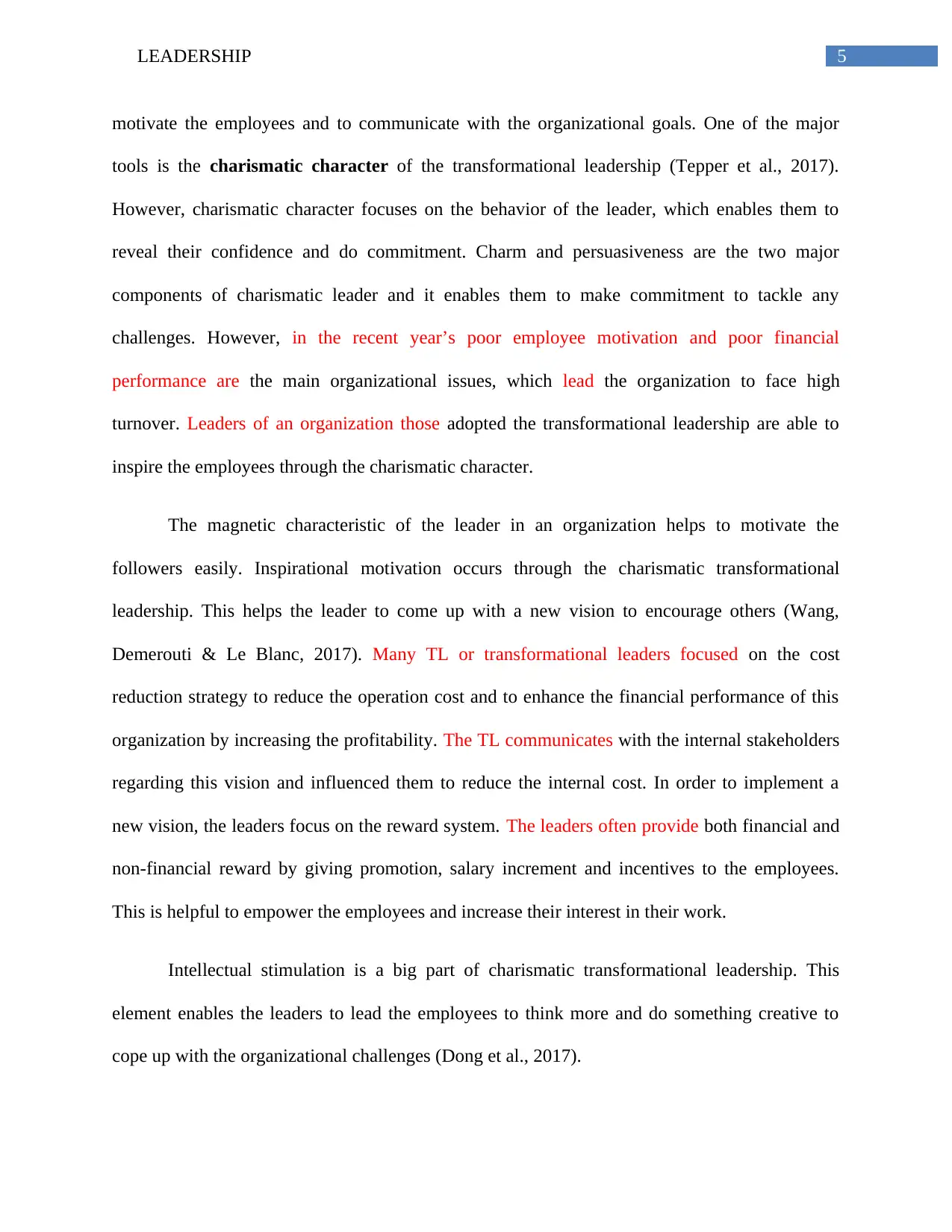
5LEADERSHIP
motivate the employees and to communicate with the organizational goals. One of the major
tools is the charismatic character of the transformational leadership (Tepper et al., 2017).
However, charismatic character focuses on the behavior of the leader, which enables them to
reveal their confidence and do commitment. Charm and persuasiveness are the two major
components of charismatic leader and it enables them to make commitment to tackle any
challenges. However, in the recent year’s poor employee motivation and poor financial
performance are the main organizational issues, which lead the organization to face high
turnover. Leaders of an organization those adopted the transformational leadership are able to
inspire the employees through the charismatic character.
The magnetic characteristic of the leader in an organization helps to motivate the
followers easily. Inspirational motivation occurs through the charismatic transformational
leadership. This helps the leader to come up with a new vision to encourage others (Wang,
Demerouti & Le Blanc, 2017). Many TL or transformational leaders focused on the cost
reduction strategy to reduce the operation cost and to enhance the financial performance of this
organization by increasing the profitability. The TL communicates with the internal stakeholders
regarding this vision and influenced them to reduce the internal cost. In order to implement a
new vision, the leaders focus on the reward system. The leaders often provide both financial and
non-financial reward by giving promotion, salary increment and incentives to the employees.
This is helpful to empower the employees and increase their interest in their work.
Intellectual stimulation is a big part of charismatic transformational leadership. This
element enables the leaders to lead the employees to think more and do something creative to
cope up with the organizational challenges (Dong et al., 2017).
motivate the employees and to communicate with the organizational goals. One of the major
tools is the charismatic character of the transformational leadership (Tepper et al., 2017).
However, charismatic character focuses on the behavior of the leader, which enables them to
reveal their confidence and do commitment. Charm and persuasiveness are the two major
components of charismatic leader and it enables them to make commitment to tackle any
challenges. However, in the recent year’s poor employee motivation and poor financial
performance are the main organizational issues, which lead the organization to face high
turnover. Leaders of an organization those adopted the transformational leadership are able to
inspire the employees through the charismatic character.
The magnetic characteristic of the leader in an organization helps to motivate the
followers easily. Inspirational motivation occurs through the charismatic transformational
leadership. This helps the leader to come up with a new vision to encourage others (Wang,
Demerouti & Le Blanc, 2017). Many TL or transformational leaders focused on the cost
reduction strategy to reduce the operation cost and to enhance the financial performance of this
organization by increasing the profitability. The TL communicates with the internal stakeholders
regarding this vision and influenced them to reduce the internal cost. In order to implement a
new vision, the leaders focus on the reward system. The leaders often provide both financial and
non-financial reward by giving promotion, salary increment and incentives to the employees.
This is helpful to empower the employees and increase their interest in their work.
Intellectual stimulation is a big part of charismatic transformational leadership. This
element enables the leaders to lead the employees to think more and do something creative to
cope up with the organizational challenges (Dong et al., 2017).
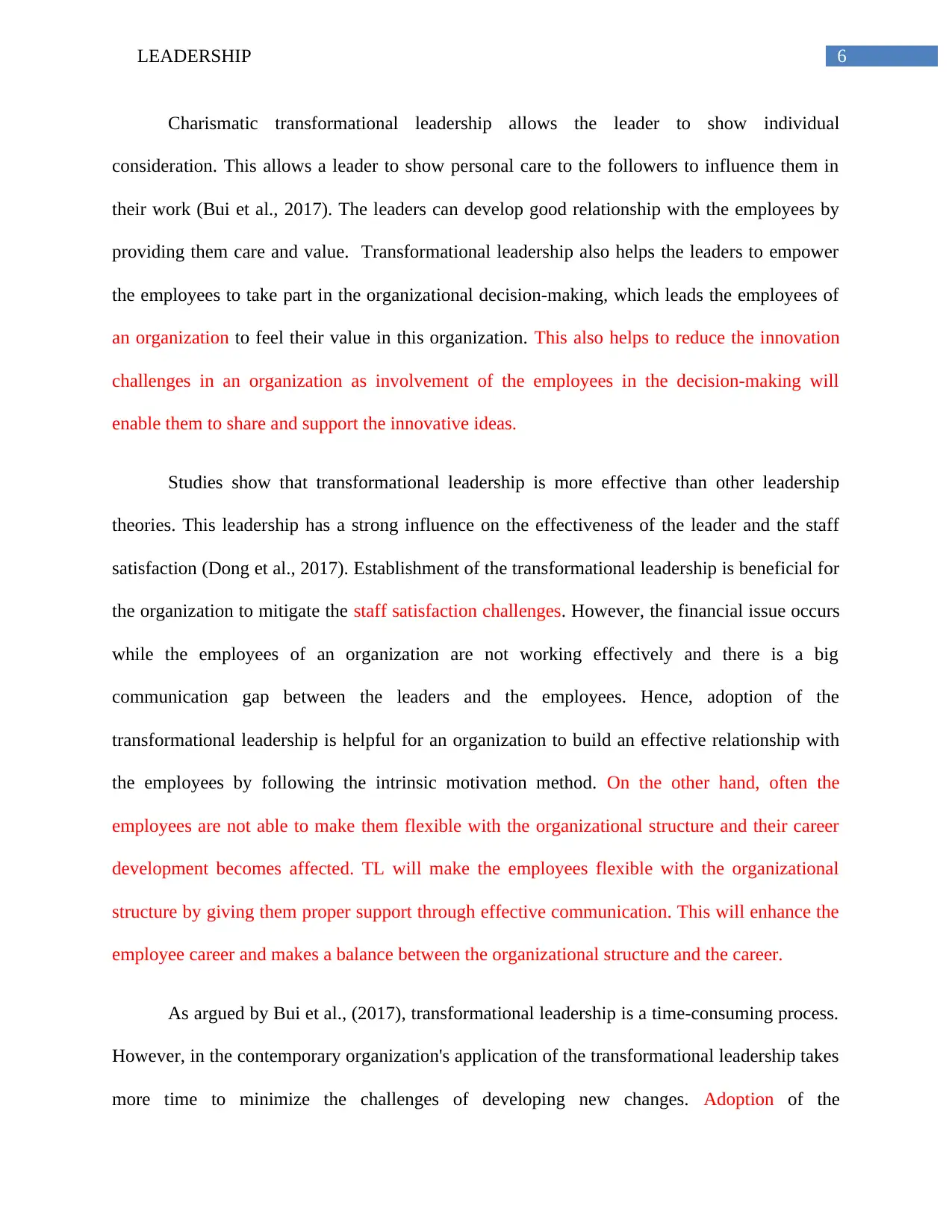
6LEADERSHIP
Charismatic transformational leadership allows the leader to show individual
consideration. This allows a leader to show personal care to the followers to influence them in
their work (Bui et al., 2017). The leaders can develop good relationship with the employees by
providing them care and value. Transformational leadership also helps the leaders to empower
the employees to take part in the organizational decision-making, which leads the employees of
an organization to feel their value in this organization. This also helps to reduce the innovation
challenges in an organization as involvement of the employees in the decision-making will
enable them to share and support the innovative ideas.
Studies show that transformational leadership is more effective than other leadership
theories. This leadership has a strong influence on the effectiveness of the leader and the staff
satisfaction (Dong et al., 2017). Establishment of the transformational leadership is beneficial for
the organization to mitigate the staff satisfaction challenges. However, the financial issue occurs
while the employees of an organization are not working effectively and there is a big
communication gap between the leaders and the employees. Hence, adoption of the
transformational leadership is helpful for an organization to build an effective relationship with
the employees by following the intrinsic motivation method. On the other hand, often the
employees are not able to make them flexible with the organizational structure and their career
development becomes affected. TL will make the employees flexible with the organizational
structure by giving them proper support through effective communication. This will enhance the
employee career and makes a balance between the organizational structure and the career.
As argued by Bui et al., (2017), transformational leadership is a time-consuming process.
However, in the contemporary organization's application of the transformational leadership takes
more time to minimize the challenges of developing new changes. Adoption of the
Charismatic transformational leadership allows the leader to show individual
consideration. This allows a leader to show personal care to the followers to influence them in
their work (Bui et al., 2017). The leaders can develop good relationship with the employees by
providing them care and value. Transformational leadership also helps the leaders to empower
the employees to take part in the organizational decision-making, which leads the employees of
an organization to feel their value in this organization. This also helps to reduce the innovation
challenges in an organization as involvement of the employees in the decision-making will
enable them to share and support the innovative ideas.
Studies show that transformational leadership is more effective than other leadership
theories. This leadership has a strong influence on the effectiveness of the leader and the staff
satisfaction (Dong et al., 2017). Establishment of the transformational leadership is beneficial for
the organization to mitigate the staff satisfaction challenges. However, the financial issue occurs
while the employees of an organization are not working effectively and there is a big
communication gap between the leaders and the employees. Hence, adoption of the
transformational leadership is helpful for an organization to build an effective relationship with
the employees by following the intrinsic motivation method. On the other hand, often the
employees are not able to make them flexible with the organizational structure and their career
development becomes affected. TL will make the employees flexible with the organizational
structure by giving them proper support through effective communication. This will enhance the
employee career and makes a balance between the organizational structure and the career.
As argued by Bui et al., (2017), transformational leadership is a time-consuming process.
However, in the contemporary organization's application of the transformational leadership takes
more time to minimize the challenges of developing new changes. Adoption of the
⊘ This is a preview!⊘
Do you want full access?
Subscribe today to unlock all pages.

Trusted by 1+ million students worldwide
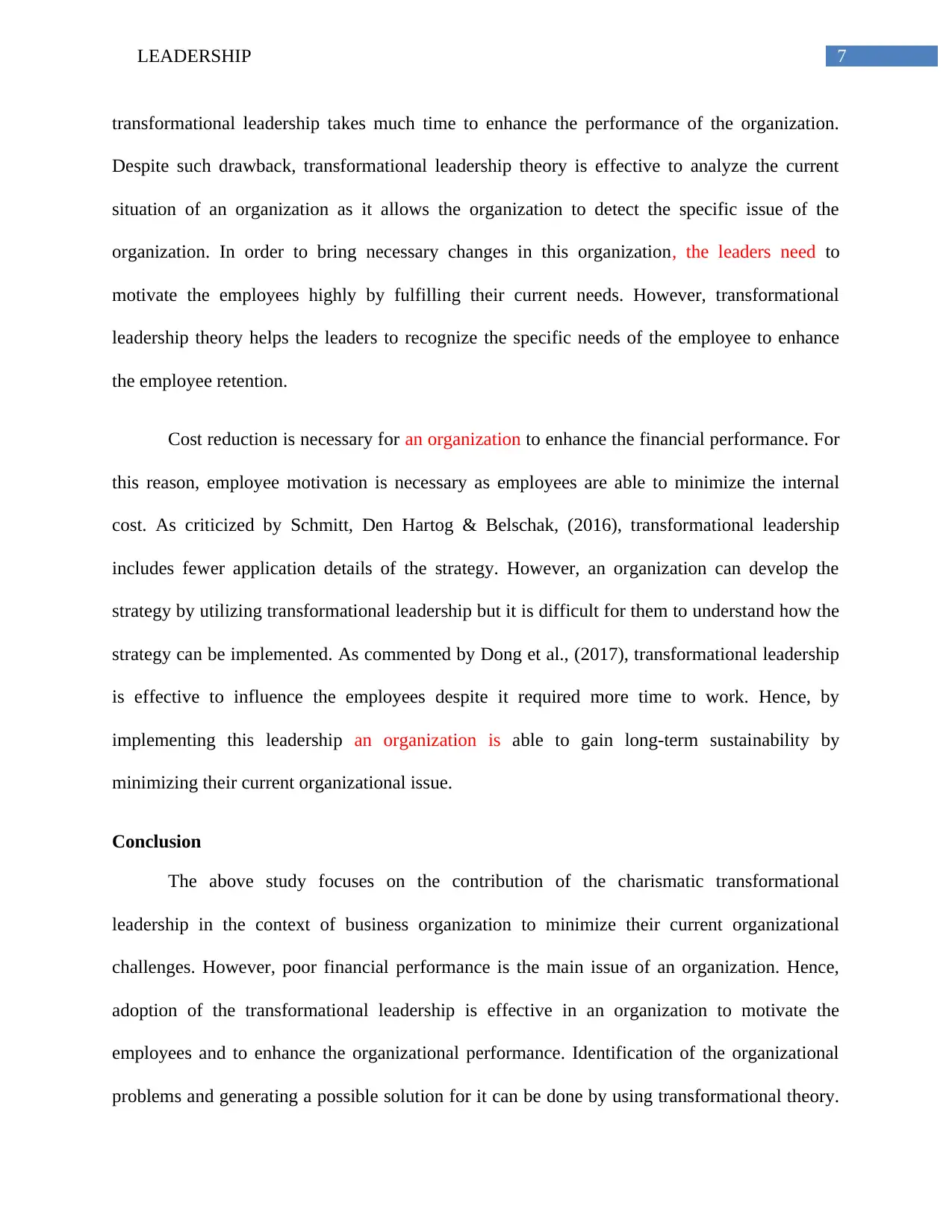
7LEADERSHIP
transformational leadership takes much time to enhance the performance of the organization.
Despite such drawback, transformational leadership theory is effective to analyze the current
situation of an organization as it allows the organization to detect the specific issue of the
organization. In order to bring necessary changes in this organization, the leaders need to
motivate the employees highly by fulfilling their current needs. However, transformational
leadership theory helps the leaders to recognize the specific needs of the employee to enhance
the employee retention.
Cost reduction is necessary for an organization to enhance the financial performance. For
this reason, employee motivation is necessary as employees are able to minimize the internal
cost. As criticized by Schmitt, Den Hartog & Belschak, (2016), transformational leadership
includes fewer application details of the strategy. However, an organization can develop the
strategy by utilizing transformational leadership but it is difficult for them to understand how the
strategy can be implemented. As commented by Dong et al., (2017), transformational leadership
is effective to influence the employees despite it required more time to work. Hence, by
implementing this leadership an organization is able to gain long-term sustainability by
minimizing their current organizational issue.
Conclusion
The above study focuses on the contribution of the charismatic transformational
leadership in the context of business organization to minimize their current organizational
challenges. However, poor financial performance is the main issue of an organization. Hence,
adoption of the transformational leadership is effective in an organization to motivate the
employees and to enhance the organizational performance. Identification of the organizational
problems and generating a possible solution for it can be done by using transformational theory.
transformational leadership takes much time to enhance the performance of the organization.
Despite such drawback, transformational leadership theory is effective to analyze the current
situation of an organization as it allows the organization to detect the specific issue of the
organization. In order to bring necessary changes in this organization, the leaders need to
motivate the employees highly by fulfilling their current needs. However, transformational
leadership theory helps the leaders to recognize the specific needs of the employee to enhance
the employee retention.
Cost reduction is necessary for an organization to enhance the financial performance. For
this reason, employee motivation is necessary as employees are able to minimize the internal
cost. As criticized by Schmitt, Den Hartog & Belschak, (2016), transformational leadership
includes fewer application details of the strategy. However, an organization can develop the
strategy by utilizing transformational leadership but it is difficult for them to understand how the
strategy can be implemented. As commented by Dong et al., (2017), transformational leadership
is effective to influence the employees despite it required more time to work. Hence, by
implementing this leadership an organization is able to gain long-term sustainability by
minimizing their current organizational issue.
Conclusion
The above study focuses on the contribution of the charismatic transformational
leadership in the context of business organization to minimize their current organizational
challenges. However, poor financial performance is the main issue of an organization. Hence,
adoption of the transformational leadership is effective in an organization to motivate the
employees and to enhance the organizational performance. Identification of the organizational
problems and generating a possible solution for it can be done by using transformational theory.
Paraphrase This Document
Need a fresh take? Get an instant paraphrase of this document with our AI Paraphraser

8LEADERSHIP
On the other hand, such theory is time-consuming and consists of fewer application details.
Despite these loopholes, the transformational theory is an effective theory to bring changes in an
organization.
On the other hand, such theory is time-consuming and consists of fewer application details.
Despite these loopholes, the transformational theory is an effective theory to bring changes in an
organization.
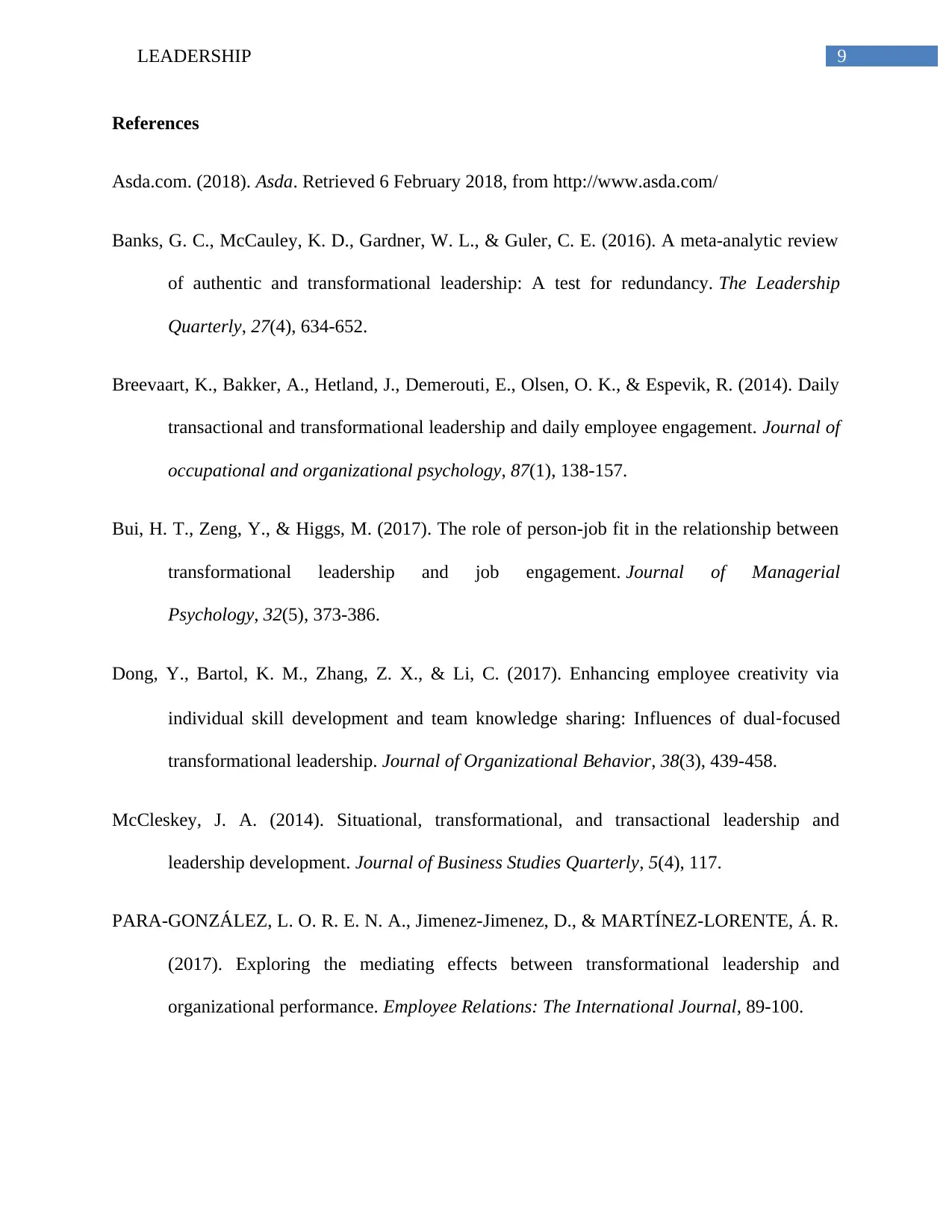
9LEADERSHIP
References
Asda.com. (2018). Asda. Retrieved 6 February 2018, from http://www.asda.com/
Banks, G. C., McCauley, K. D., Gardner, W. L., & Guler, C. E. (2016). A meta-analytic review
of authentic and transformational leadership: A test for redundancy. The Leadership
Quarterly, 27(4), 634-652.
Breevaart, K., Bakker, A., Hetland, J., Demerouti, E., Olsen, O. K., & Espevik, R. (2014). Daily
transactional and transformational leadership and daily employee engagement. Journal of
occupational and organizational psychology, 87(1), 138-157.
Bui, H. T., Zeng, Y., & Higgs, M. (2017). The role of person-job fit in the relationship between
transformational leadership and job engagement. Journal of Managerial
Psychology, 32(5), 373-386.
Dong, Y., Bartol, K. M., Zhang, Z. X., & Li, C. (2017). Enhancing employee creativity via
individual skill development and team knowledge sharing: Influences of dual‐focused
transformational leadership. Journal of Organizational Behavior, 38(3), 439-458.
McCleskey, J. A. (2014). Situational, transformational, and transactional leadership and
leadership development. Journal of Business Studies Quarterly, 5(4), 117.
PARA-GONZÁLEZ, L. O. R. E. N. A., Jimenez-Jimenez, D., & MARTÍNEZ-LORENTE, Á. R.
(2017). Exploring the mediating effects between transformational leadership and
organizational performance. Employee Relations: The International Journal, 89-100.
References
Asda.com. (2018). Asda. Retrieved 6 February 2018, from http://www.asda.com/
Banks, G. C., McCauley, K. D., Gardner, W. L., & Guler, C. E. (2016). A meta-analytic review
of authentic and transformational leadership: A test for redundancy. The Leadership
Quarterly, 27(4), 634-652.
Breevaart, K., Bakker, A., Hetland, J., Demerouti, E., Olsen, O. K., & Espevik, R. (2014). Daily
transactional and transformational leadership and daily employee engagement. Journal of
occupational and organizational psychology, 87(1), 138-157.
Bui, H. T., Zeng, Y., & Higgs, M. (2017). The role of person-job fit in the relationship between
transformational leadership and job engagement. Journal of Managerial
Psychology, 32(5), 373-386.
Dong, Y., Bartol, K. M., Zhang, Z. X., & Li, C. (2017). Enhancing employee creativity via
individual skill development and team knowledge sharing: Influences of dual‐focused
transformational leadership. Journal of Organizational Behavior, 38(3), 439-458.
McCleskey, J. A. (2014). Situational, transformational, and transactional leadership and
leadership development. Journal of Business Studies Quarterly, 5(4), 117.
PARA-GONZÁLEZ, L. O. R. E. N. A., Jimenez-Jimenez, D., & MARTÍNEZ-LORENTE, Á. R.
(2017). Exploring the mediating effects between transformational leadership and
organizational performance. Employee Relations: The International Journal, 89-100.
⊘ This is a preview!⊘
Do you want full access?
Subscribe today to unlock all pages.

Trusted by 1+ million students worldwide
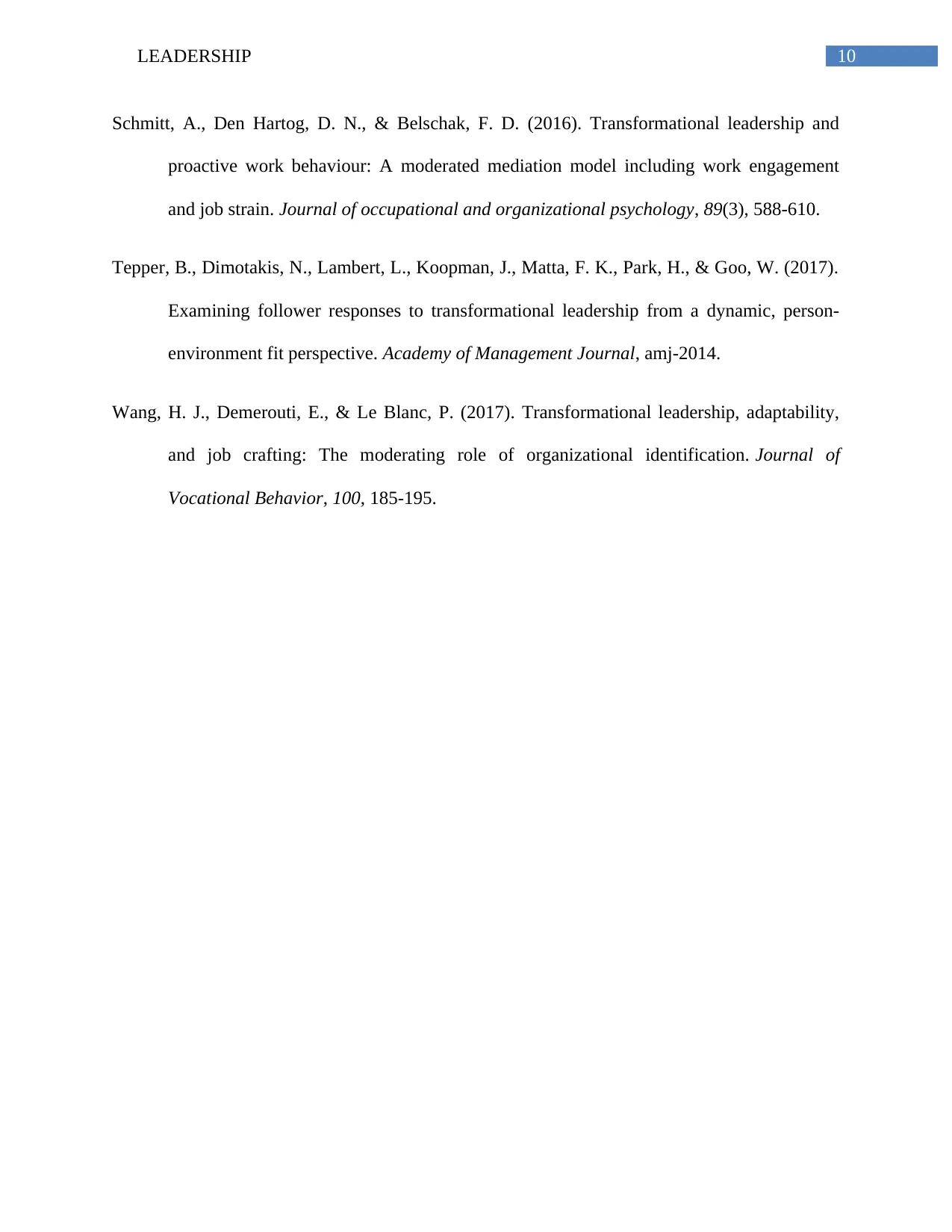
10LEADERSHIP
Schmitt, A., Den Hartog, D. N., & Belschak, F. D. (2016). Transformational leadership and
proactive work behaviour: A moderated mediation model including work engagement
and job strain. Journal of occupational and organizational psychology, 89(3), 588-610.
Tepper, B., Dimotakis, N., Lambert, L., Koopman, J., Matta, F. K., Park, H., & Goo, W. (2017).
Examining follower responses to transformational leadership from a dynamic, person-
environment fit perspective. Academy of Management Journal, amj-2014.
Wang, H. J., Demerouti, E., & Le Blanc, P. (2017). Transformational leadership, adaptability,
and job crafting: The moderating role of organizational identification. Journal of
Vocational Behavior, 100, 185-195.
Schmitt, A., Den Hartog, D. N., & Belschak, F. D. (2016). Transformational leadership and
proactive work behaviour: A moderated mediation model including work engagement
and job strain. Journal of occupational and organizational psychology, 89(3), 588-610.
Tepper, B., Dimotakis, N., Lambert, L., Koopman, J., Matta, F. K., Park, H., & Goo, W. (2017).
Examining follower responses to transformational leadership from a dynamic, person-
environment fit perspective. Academy of Management Journal, amj-2014.
Wang, H. J., Demerouti, E., & Le Blanc, P. (2017). Transformational leadership, adaptability,
and job crafting: The moderating role of organizational identification. Journal of
Vocational Behavior, 100, 185-195.
1 out of 10
Related Documents
Your All-in-One AI-Powered Toolkit for Academic Success.
+13062052269
info@desklib.com
Available 24*7 on WhatsApp / Email
![[object Object]](/_next/static/media/star-bottom.7253800d.svg)
Unlock your academic potential
Copyright © 2020–2025 A2Z Services. All Rights Reserved. Developed and managed by ZUCOL.





